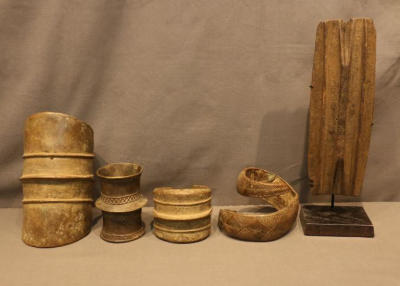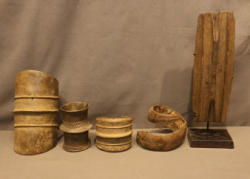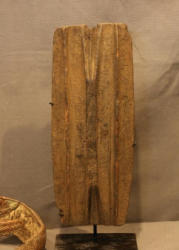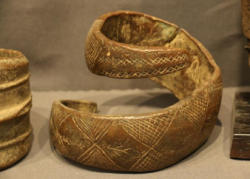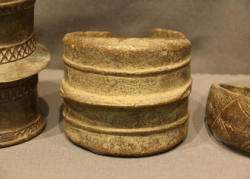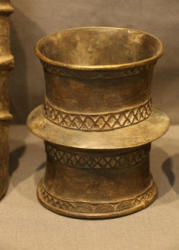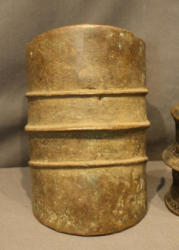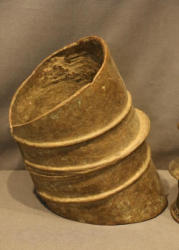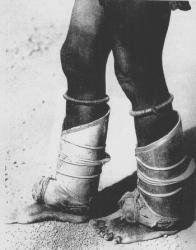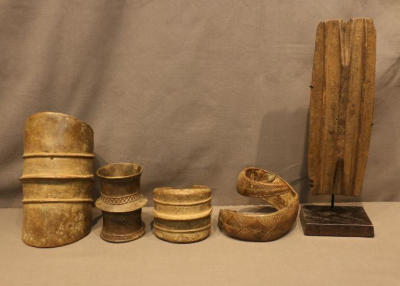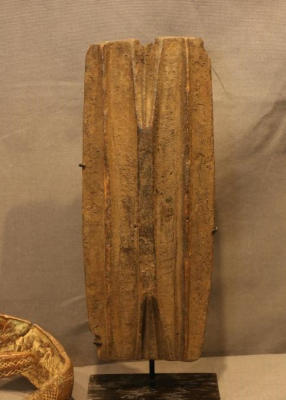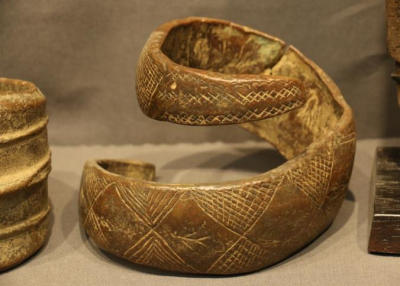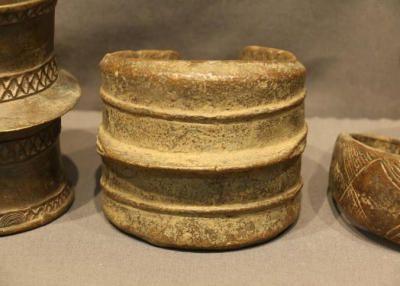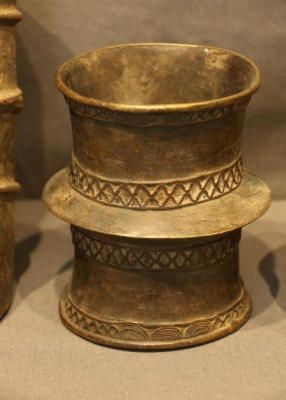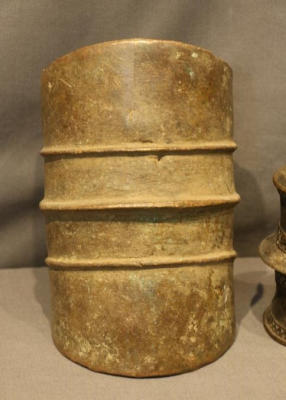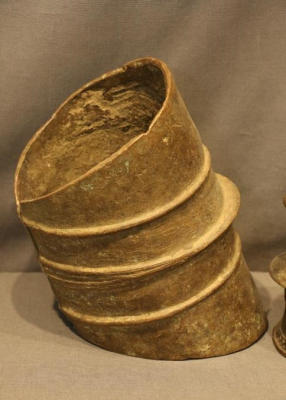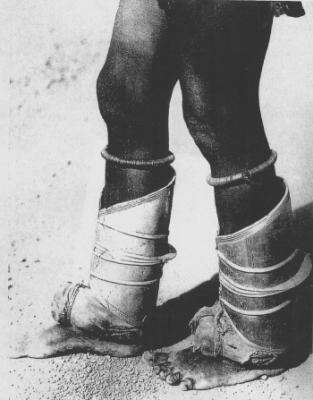Items located in Pleasant Valley, NY. Items include Faro, the water genie puppet from Mali; West African double gongs; Ode-lay society head crest mask from Sierra Leone; African sculptures, figurines, masks, textiles, ceremonial robes, copper rod currency, and more.
AFRICAN ART COLLECTION OF MARY SUE AND PAUL PETER ROSEN
Mary Sue and Paul Peter Rosen have collected African art for over thirty years, making nine trips to Africa to study the art in its cultural setting. The Rosens have published three African art books, curated more than ten exhibitions from their collection, and have given public lectures about African art and culture. They have donated art from their collection to various institutions including the Newark Museum, Temple University in Philadelphia, the SMA Fathers African Art Museum in Tenafly, New Jersey, and the African American Research Library in Fort Lauderdale, Florida.
Payment is due by Monday, April 1 at 1PM.
Pickup in Pleasant Valley, NY must be completed by Monday, April 1 at 3PM.
All lots sold as is, where is. There is a 15% Buyers Premium for all lots purchased. Payment methods include cash, MC, Visa, Discover or good check. You can make credit card payment online by going to your Member Area and selecting your invoice.
*NOTE* Shipping is available on all items.
AFRICAN ART COLLECTION OF MARY SUE AND PAUL PETER ROSEN
Mary Sue and Paul Peter Rosen have collected African art for over thirty years, making nine trips to Africa to study the art in its cultural setting. The Rosens have published three African art books, curated more than ten exhibitions from their collection, and have given public lectures about African art and culture. They have donated art from their collection to various institutions including the Newark Museum, Temple University in Philadelphia, the SMA Fathers African Art Museum in Tenafly, New Jersey, and the African American Research Library in Fort Lauderdale, Florida.
Payment is due by Monday, April 1 at 1PM.
Pickup in Pleasant Valley, NY must be completed by Monday, April 1 at 3PM.
All lots sold as is, where is. There is a 15% Buyers Premium for all lots purchased. Payment methods include cash, MC, Visa, Discover or good check. You can make credit card payment online by going to your Member Area and selecting your invoice.
*NOTE* Shipping is available on all items.
?EMBLEMS OF POWER. ASAFO FLAGS FROM GHANA? BY M.S. AND P.P. ROSEN IS ONLY AVAILABLE FROM THE AUTHORS AT ppr2001@med.cornell.edu PRICE POSTPAID IN US IS $25.00; OUTSIDE US POSTPAID $35.00.
Auction Info
Items located in Pleasant Valley, NY. Items include Faro, the water genie puppet from Mali; West African double gongs; Ode-lay society head crest mask from Sierra Leone; African sculptures, figurines, masks, textiles, ceremonial robes, copper rod currency, and more.
AFRICAN ART COLLECTION OF MARY SUE AND PAUL PETER ROSEN
Mary Sue and Paul Peter Rosen have collected African art for over thirty years, making nine trips to Africa to study the art in its cultural setting. The Rosens have published three African art books, curated more than ten exhibitions from their collection, and have given public lectures about African art and culture. They have donated art from their collection to various institutions including the Newark Museum, Temple University in Philadelphia, the SMA Fathers African Art Museum in Tenafly, New Jersey, and the African American Research Library in Fort Lauderdale, Florida.
Payment is due by Monday, April 1 at 1PM.
Pickup in Pleasant Valley, NY must be completed by Monday, April 1 at 3PM.
All lots sold as is, where is. There is a 15% Buyers Premium for all lots purchased. Payment methods include cash, MC, Visa, Discover or good check. You can make credit card payment online by going to your Member Area and selecting your invoice.
*NOTE* Shipping is available on all items.
AFRICAN ART COLLECTION OF MARY SUE AND PAUL PETER ROSEN
Mary Sue and Paul Peter Rosen have collected African art for over thirty years, making nine trips to Africa to study the art in its cultural setting. The Rosens have published three African art books, curated more than ten exhibitions from their collection, and have given public lectures about African art and culture. They have donated art from their collection to various institutions including the Newark Museum, Temple University in Philadelphia, the SMA Fathers African Art Museum in Tenafly, New Jersey, and the African American Research Library in Fort Lauderdale, Florida.
Payment is due by Monday, April 1 at 1PM.
Pickup in Pleasant Valley, NY must be completed by Monday, April 1 at 3PM.
All lots sold as is, where is. There is a 15% Buyers Premium for all lots purchased. Payment methods include cash, MC, Visa, Discover or good check. You can make credit card payment online by going to your Member Area and selecting your invoice.
*NOTE* Shipping is available on all items.
?EMBLEMS OF POWER. ASAFO FLAGS FROM GHANA? BY M.S. AND P.P. ROSEN IS ONLY AVAILABLE FROM THE AUTHORS AT ppr2001@med.cornell.edu PRICE POSTPAID IN US IS $25.00; OUTSIDE US POSTPAID $35.00.
Categories:
FOUR WEST AFRICAN ANKLETS. (A) Wodaabe people, Niger. The Wodaabe people lead a nomadic life in the southern Sahara. Light weight anklets such as this are worn by young girls as a form of jewelry. The anklet is commissioned from a Hausa blacksmith who decorates it with symbols having meaning to the Wodaabe as instructed by the person who orders it. Brass. H 5in. (B) Kutu and Mongo people, Congo. This heavy anklet/leg band is forged by a blacksmith who pours molten brass into a mold. The mold is created by pressing a wooden form (B1) in specially prepared wet sand mixed with clay which hardens like concrete when dry. While the metal is still very hot, the ingot is bent over the trunk of a tree to achieve the correct shape. The anklet is worn by a woman during celebratory events as a sign of wealth. Her feet and ankles are protected with pads of cloth and leaves (litelele). See picture. The anklets are also a form of currency in important transactions. A high sheen is created by polishing the surface with a smooth stone. H 9in Weight 5.6lb. Wood form on custom base. H 12in. (C) A smaller version of the anklet in (B). Brass. H 4in. Weight 3.4lb. (D) Ngelima people, Congo. Spiral anklet with engraved diamond-shaped designs. Brass. H 4.5in. Weight 3.4lb.
More Details
FOUR WEST AFRICAN ANKLETS. (A) Wodaabe people, Niger. The Wodaabe people lead a nomadic life in the southern Sahara. Light weight anklets such as this are worn by young girls as a form of jewelry. The anklet is commissioned from a Hausa blacksmith who decorates it with symbols having meaning to the Wodaabe as instructed by the person who orders it. Brass. H 5in. (B) Kutu and Mongo people, Congo. This heavy anklet/leg band is forged by a blacksmith who pours molten brass into a mold. The mold is created by pressing a wooden form (B1) in specially prepared wet sand mixed with clay which hardens like concrete when dry. While the metal is still very hot, the ingot is bent over the trunk of a tree to achieve the correct shape. The anklet is worn by a woman during celebratory events as a sign of wealth. Her feet and ankles are protected with pads of cloth and leaves (litelele). See picture. The anklets are also a form of currency in important transactions. A high sheen is created by polishing the surface with a smooth stone. H 9in Weight 5.6lb. Wood form on custom base. H 12in. (C) A smaller version of the anklet in (B). Brass. H 4in. Weight 3.4lb. (D) Ngelima people, Congo. Spiral anklet with engraved diamond-shaped designs. Brass. H 4.5in. Weight 3.4lb.
High Bid:
$110.00 – estate
Auction Type: One Lot
Quantity: 1
Bidding has closed on this lot

